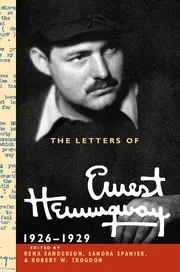The Letters of Ernest Hemingway
Volume 3, 1926–1929
(Author) Ernest HemingwayThe Letters of Ernest Hemingway, Volume 3: 1926-1929, featuring many previously unpublished letters, follows a rising star as he emerges from the literary Left Bank of Paris and moves into the American mainstream. Maxwell Perkins, legendary editor at Scribner's, nurtured the young Hemingway's talent, accepting his satirical novel Torrents of Spring (1926) in order to publish what would become a signature work of the twentieth century: The Sun Also Rises (1926). By early 1929 Hemingway had completed A Farewell to Arms. Hemingway's letters of this period also reflect landmark events in his personal life, including the dissolution of his first marriage, his remarriage, the birth of his second son, and the suicide of his father. As the volume ends in April 1929, Hemingway is setting off from Key West to return to Paris and standing on the cusp of celebrity as one of the major writers of his time.
Ernest Hemingway
Ernest Hemingway (1899-1961) was an American novelist, short story writer, and journalist known for his distinctive writing style and portrayal of masculinity. His most notable works include "The Old Man and the Sea," "A Farewell to Arms," and "The Sun Also Rises." Hemingway's writing is characterized by its spare prose, realistic dialogue, and emphasis on themes of war, love, and loss. He is credited with revolutionizing the modern American novel and influencing generations of writers with his minimalist approach to storytelling. "The Old Man and the Sea," a novella about an aging fisherman's struggle with a marlin, remains one of Hemingway's most famous and enduring works, winning him the Pulitzer Prize for Fiction in 1953 and solidifying his reputation as a literary giant.






